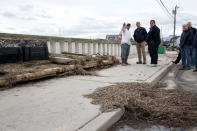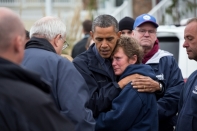Monitoring Hurricane Sandy
As Hurricane Sandy moves away from the Bahamas and toward the East Coast of the United States, forecasters with the National Weather Center are tracking the path of the storm, while FEMA offices from Atlanta to Boston are readying for a potential impact.
Earlier today, President Obama spoke on the phone with FEMA Administrator Craig Fugate, Dr. Rick Knabb, Director of the National Hurricane Center, and John Brennan, Assistant to the President for Homeland Security and Counterterrorism about the ongoing preparations.
FEMA is currently advising residents in the path of Sandy (which includes those on much of the East Coast) to prepare for tropical storm and hurricane conditions. Here are a set of basic safety tips they shared last night:
- For the severe weather forecast for your area, listen to your NOAA Weather Radio, local media and forecast reports.
- Check on the items in your family’s emergency kit - Remember to include items like a flashlight, hand-crank radio, and a solar powered cell phone charger to your emergency kit. Hurricanes often bring power outages, so be sure your emergency kit can sustain your family for at least 72 hours after the storm.
- Make a plan for how you will contact friends and family in the event of an emergency. Flooding is often the most significant threat from hurricanes and tropical storms - avoid walking or driving through flooded areas – it only takes six inches of fast-moving flood water to knock over an adult and two feet to move a vehicle.
- As always, follow the direction of local officials. Don’t put yourself at risk, if they give the order to evacuate, do so immediately.
For more tips on preparing your home and family for the effects of a hurricane or tropical storm, visit www.ready.gov/hurricanes.


















